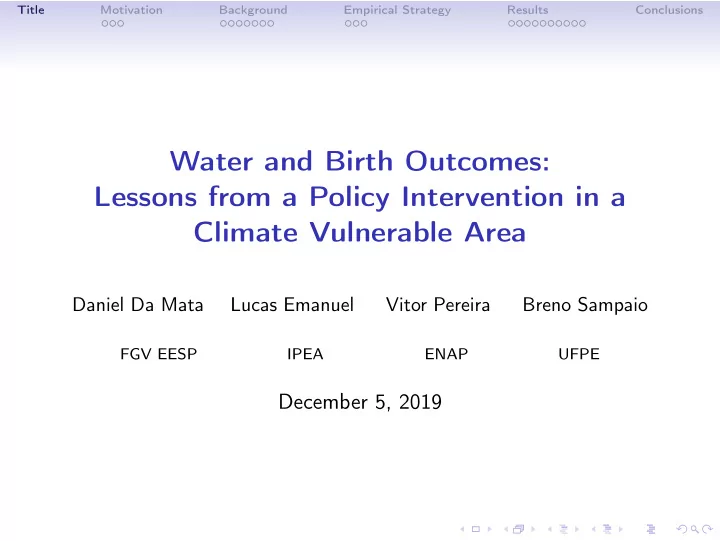

Title Motivation Background Empirical Strategy Results Conclusions Water and Birth Outcomes: Lessons from a Policy Intervention in a Climate Vulnerable Area Daniel Da Mata Lucas Emanuel Vitor Pereira Breno Sampaio FGV EESP IPEA ENAP UFPE December 5, 2019
Title Motivation Background Empirical Strategy Results Conclusions Motivation • About 4 billion people experience severe water scarcity during at least one month of the year (UN-Water, 2019) • Water stress is a major challenge for poor rural populations • where traditional water policies (e.g., sanitation) are likely to be unfeasible • Availability and quality of drinking water is important during pregnancy (Currie et al 2013; Almond et al 2018) • This paper studies how in utero exposure to a large-size water harvesting program affects birth outcomes
Title Motivation Background Empirical Strategy Results Conclusions The Paper in a Nutshell • We exploit the precise timing of increased exposure in utero to rainwater tanks based on the roll-out of a large-scale program • Cistern Program: 1 million rainwater tanks in Brazil’s poorest and driest region • Data from different administrative registries • Main Results • Sizable effect on birth weight • Effects stronger for more educated mothers
Title Motivation Background Empirical Strategy Results Conclusions Literature and Contribution We contribute to different strands of the literature • Effects of a large-scale adaptation policy on health • Literature on the impacts of in-kind welfare programs • Adds to the place-based policies literature
Title Motivation Background Empirical Strategy Results Conclusions First Water Cisterns Program
Title Motivation Background Empirical Strategy Results Conclusions Semiarid Region Figure: Yearly precipitation in Brazilian Semiarid Northeast and in the rest of Brazil, 2011-2016, in mm Semiarid Rest of Brazil 1800 1500 1200 900 600 300 2011 2012 2013 2014 2015 2016 year
Title Motivation Background Empirical Strategy Results Conclusions First Water Cisterns Program Source: Ministry of Social Development.
Title Motivation Background Empirical Strategy Results Conclusions Data • CadÚnico (2011-2018) • First Water Cisterns Program (2003-2017) • SINASC (2011-2017) • Merge: • CadÚnico + First Water Cisterns Program • CadÚnico and First Water Cisterns Program + SINASC
Title Motivation Background Empirical Strategy Results Conclusions Sample • Expected date of birth at conception (280 days) as an exogenous measure of gestational length • Our sample P is given by: P = { i : c ≤ Cisterns ≤ b exp } = { i : c ≤ Cisterns ≤ c + 280 }
Title Motivation Background Empirical Strategy Results Conclusions Sample • Expected date of birth at conception (280 days) as an exogenous measure of gestational length • Our sample P is given by: P = { i : c ≤ Cisterns ≤ b exp } = { i : c ≤ Cisterns ≤ c + 280 }
Title Motivation Background Empirical Strategy Results Conclusions Location of the Individuals of our Sample
Title Motivation Background Empirical Strategy Results Conclusions Correlation: weeks of exposure and birth weight
Title Motivation Background Empirical Strategy Results Conclusions Empirical Strategy • Main specification: (1) Y imts = µ s + γ mt + β · weeks_exposure imts + X ′ imts Θ+ ε imts • weeks _ exposure itm : measures the difference in weeks between the expected date of birth and the cistern’s date of construction • µ s : Municipality fixed effect • γ mt : Month by Year of Conception fixed effect • X i : Controls • Priority criteria variables • Delivery and mother’s characteristics • Housing structure characteristics
Title Motivation Background Empirical Strategy Results Conclusions Empirical Strategy • Alternative specification: Y imts = µ s + γ mt + α · trim1 imts + δ · trim2 imts + X ′ (2) imts Θ+ ε imts • trim 1 itm (from the date of last menstruation plus 93 days) • trim 2 itm (between 94 and 187 days after conception)
Title Motivation Background Empirical Strategy Results Conclusions Histogram Figure: Histogram of cisterns by week of gestation .03 .02 Density .01 0 0 10 20 30 40 weeks of gestation
Title Motivation Background Empirical Strategy Results Conclusions Main Results
Title Motivation Background Empirical Strategy Results Conclusions Main Results
Title Motivation Background Empirical Strategy Results Conclusions Stata code
Title Motivation Background Empirical Strategy Results Conclusions Heterogeneous response
Title Motivation Background Empirical Strategy Results Conclusions Mechanisms Quantity of Water, Quality of Water, Stress level, Maternal Nutrition, Time collecting water
Title Motivation Background Empirical Strategy Results Conclusions Adoption
Title Motivation Background Empirical Strategy Results Conclusions Additional exercises • Other outcomes • APGAR 1, 5 • Cesarean • Newborn female • Prenatal visits • Dropping subsamples • Additional Controls and Fixed Effects • Analysis with older siblings • Plabeco interventions
Title Motivation Background Empirical Strategy Results Conclusions Older sibling
Title Motivation Background Empirical Strategy Results Conclusions Placebo interventions: Randomization of weeks of exposure 1 .8 Empirical CDF .6 p=0.021 .4 .2 0 −3.000 −2.000 −1.000 0.000 1.000 2.000 Estimates
Title Motivation Background Empirical Strategy Results Conclusions Alternative specification
Title Motivation Background Empirical Strategy Results Conclusions Final remarks • Each additional week of exposure to cisterns is associated with a positive effect on average birth weight of 1.5 – 1.7 gram • The effect is stronger for literate mothers • The main channel in our setting seems to be the water quality • Policies for adaptation and reduction of vulnerability may bring about positive effects on an important predictor of future individual outcomes
Recommend
More recommend